topic 3 - exchange & transport system
1/159
There's no tags or description
Looks like no tags are added yet.
Name | Mastery | Learn | Test | Matching | Spaced |
|---|
No study sessions yet.
160 Terms
What is the formula for Pulmonary Ventilation?
• PV = tidal volume x ventilation rate
• tidal volume = volume of air breathed in/out in one breath
• ventilation rate = number of breaths per minute
• Pulmonary Ventilation = volume of air breathed in/out per minute
What do the intestine absorb?
• Small Intestine absorbs small soluble nutrients (glucose, amino acids, monoglyceride and fatty acid, vitamins and minerals)
• Large Intestine absorbs water
What do the blood vessels of the heart do?
• artery takes blood away from the heart, vein returns blood to the heart
• Vena Cava supplies R atrium (with deoxygenated blood from body)
• Pulmonary Vein supplies L atrium (with oxygenated blood from lungs)
• R ventricle supplies Pulmonary Artery (deoxygenated blood to lungs)
• L ventricle supplies Aorta (oxygenated blood to body)

What is the formula for Cardiac Output?
• CO = Stroke Volume x Heart Rate
• stroke volume = volume of blood pumped out of the heart in one beat
• heart rate = number of beats per minute
• Cardiac Output = volume of blood pumped out of the heart in one minute
What is the role of Veins/Venules?
• generally carry deoxygenated blood back to the heart
• for example, Coronary Vein from heart muscle
• Hepatic Vein from liver
• Renal Vein from kidneys
• exception 1 = Pulmonary Vein carries oxygenated blood back to the heart
• exception 2 = Hepatic Portal Vein carries deoxygenated blood from digestive system to liver (for filtering)
What is the function of Capillaries?
• site of exchange
• 3 locations,
• With Alveoli, takes in O2 and removes CO2
• With Microvilli, takes in glucose/amino acids/monoglyceride and fatty acids/vitamins/minerals
• With All Cells, deliver nutrients and remove waste
How are the capillaries adapted for faster diffusion?
• many small capillaries = large surface area
• thin wall, one cell thick, squamous epithelial cells = short diffusion distance
• pores between cells = allows fluid to move in and out
• narrow lumen = increase diffusion time and decrease diffusion distance
How does exchange occur between Capillaries & All Cells?
• by mass flow
• fluid moves out of the blood in the capillaries carrying the nutrients
• fluid moves back into blood in the capillaries carrying the waste
• (fluid in the blood called plasma, fluid surrounding cells called tissue fluid, fluid in lymph system called lymph)
Why does diet low in protein cause accumulation of tissue fluid?
• the water potential in the capillary is not as low as normal, so not as much fluid can move back into the capillary by osmosis
What is translocation?
Movement of solutes/assimilates up and down a plant to where they are needed most.
Requires energy.

What is a sink vs a source?
Source - where solutes are produced usually leaves but also storage
Sink - where the solutes are used up - could also be leaves etc
What is the job of the Roots?
• absorb water and minerals
• absorbs water by osmosis
• absorbs minerals by active transport
• plants need water for photosynthesis, cytoplasm hydration, turgidity of cells
• plants need magnesium, nitrate, phosphate (magnesium to make chlorophyll, nitrate to make amino acids, phosphate to make phospholipids/ATP/DNA)
What is the function of the Xylem?
transport water and minerals from roots, up the plant, to the leaves
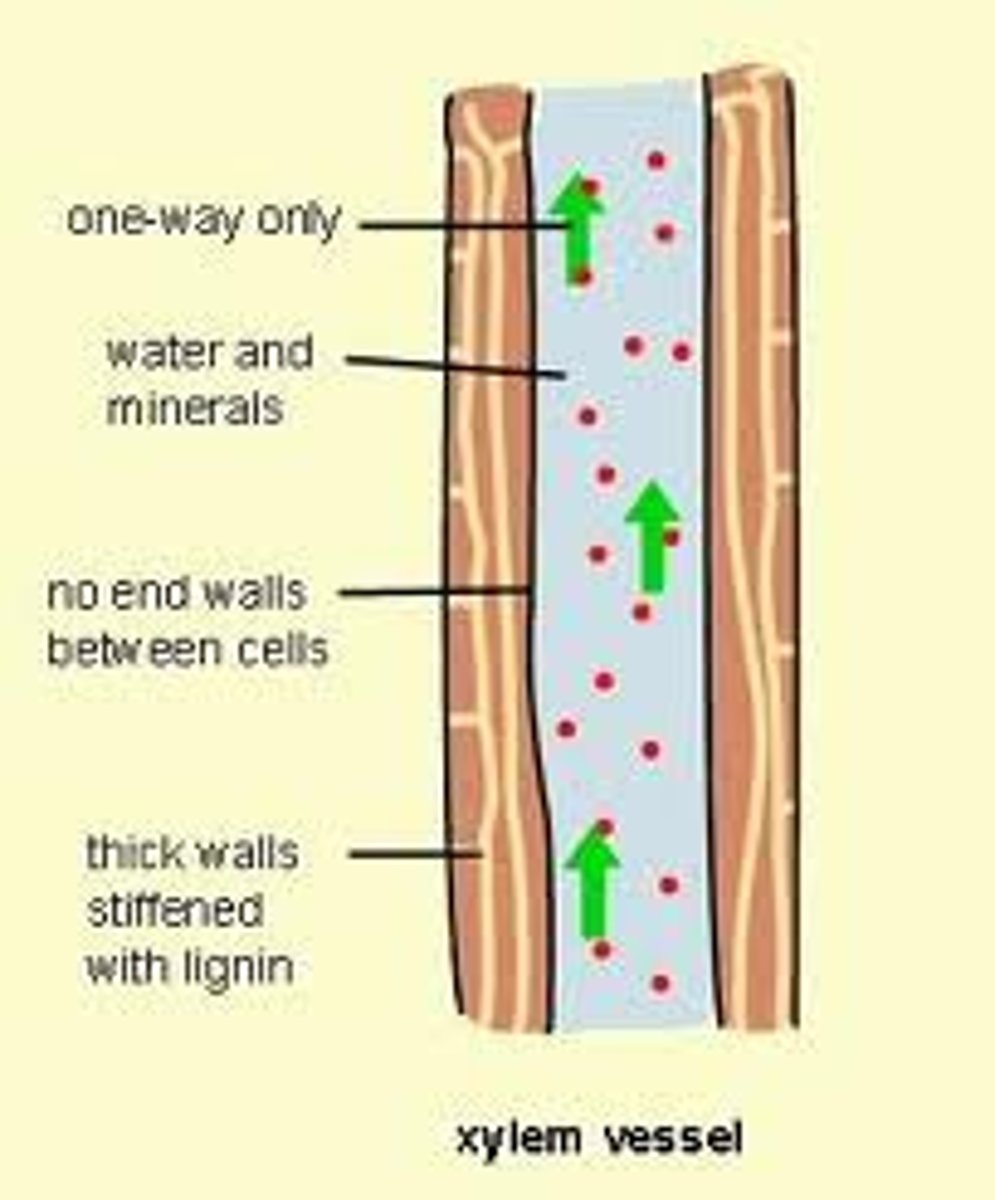
What is the structure of the xylem?
long continuous hollow tube (no resistance to water flow) narrow lumen
wall made out of dead cells joined end to end - no end walls
strengthened by lignin as the cells mature : strong, waterproof, adhesive
lignin also forms spiral annular rings around the xylem giving the walls extra strength to resist water pressure & structural support to the plant
wall contains pits/pores (water and minerals can leave)
How does water move up the xylem - Cohesion Tension Theory?
evaporation of water into the intercellular air spaces in leaves - transpiration
this creates a greater tension on the water in mesophyll cells
this increases the pull on the water in the xylem vessels
water moves from the top of the xylem into the leaf by osmosis because of the tension/negative pressure
water is being continuously lost from transpiration in the leaves
the loss of water exerts a pull on the water in the xylem ducts & draws more water into the leaf
this applies TENSION to the column of water in the xylem
the column of water moves up as one as the water particles stick together, COHESION
How is the movement of water up the xylem - Cohesion Tension Theory facilitated by capillary action, adhesion and root pressure?
capillary action = water automatically moves up narrow lumen of xylem
adhesion = water particles stick to lignin in wall of xylem so water moves as one column
root pressure = water absorbed at the roots pushes the column of water up slightly by hydrostatic pressure
How are the xylem vessels structurally adapted?
Rings of lignin maintain their tubular shape
Small perforations reduces the formation of gas bubbles in the xylem which would interrupt the continuous stream of water from the base to the top of the plants and the size of any gas bubbles formed
This means the xylem is adapted to both outward pressure - could cause it to burst & inward pull - could cause the vessel to collapse
Why does the diameter of a tree decrease during the day?
• more light and higher temperature
• increase rate of transpiration
• increase transpirational pull
• water pulled up xylem by cohesion-tension
• because the water particles stick to the wall of the xylem (adhesion)
• the walls of the xylem are pulled inwards
How are the palisade cells adapted for photosynthesis (5)?
• located near top of leaf, closer to light
• large size, large surface area for light
• thin cell wall, short diffusion distance for carbon dioxide
• contains many chloroplasts, site of photosynthesis
• large vacuole, pushes chloroplast to the edge of the cell closer to light
How does Exchange occur in Leaves?
• lower epidermis of leaf contains pairs of cells called Guard Cells
• when turgid, guard cells form an opening called Stomata
• gas exchange occurs via the stomata
• In Day, plant photosynthesises and respires, CO2 moves in for photosysnthesis and O2 moves out (some is used in respiration)
• At Night, plant only respires, O2 moves in for respiration and CO2 moves out
What is Transpiration?
loss of water vapour from the leaf via the stomata
How does Transpiration occur?
• moist lining of spongy mesophyll cells evaporate forming water vapour
• water vapour builds up in air spaces
• if water vapour concentration is high enough & stomata is open, water vapour diffuses out as conc of water is higher in the cell than in the air
What are the factors that increase rate of transpiration?
• light = more light, more stomata open, increase surface area for transpiration
• temperature = higher temperature, more evaporation (increase water vapour concentration) & more kinetic energy
• wind = more wind, maintains concentration gradient
• humidity = less humidity, less water vapour in the surrounding air, increase in water vapour concentration gradient
What is a Potometer?
apparatus used to measure rate of transpiration

What is the principle of a potometer?
• as transpiration occurs from the leaves, the plant will pull up more water from the potometer by cohesion-tension causing the bubble to move towards the plant
• the more water lost by transpiration, the more water taken up, the further the bubble moves
How do you measure the rate of transpiration?
• rate of transpiration = volume of transpiration divided by time
• for volume of transpiration, distance bubble moved x cross-sectional area of tube (πr2)
How do you set up a potometer?
• choose healthy leaf and shoot
• cut shoot underwater and connect to potometer underwater (prevents air bubbles entering/blocking xylem)
• ensure potometer is air tight and water tight
What does a potometer actually measure?
• measures rate of water uptake as a result of water loss from plant
• (water loss can be due to: transpiration, photosynthesis, making cells turgid, loss from potometer)
What is a Xerophyte?
a plant adapted to reduce water loss (reduce transpiration)
What is the function of Phloem?
transport organic solutes (e.g. Sucrose) up and down a plant
What is the structure of phloem?
Like the xylem the phloem is formed from cells arranged in tubes but the phloem has :
Sieve tube elements - living cells that form the tube for transporting solutes - have no nuclei & few organelles
Companion cells - pair with sieve tube elements - contain mitochondria which provides the energy required for active transport
Sieve plates
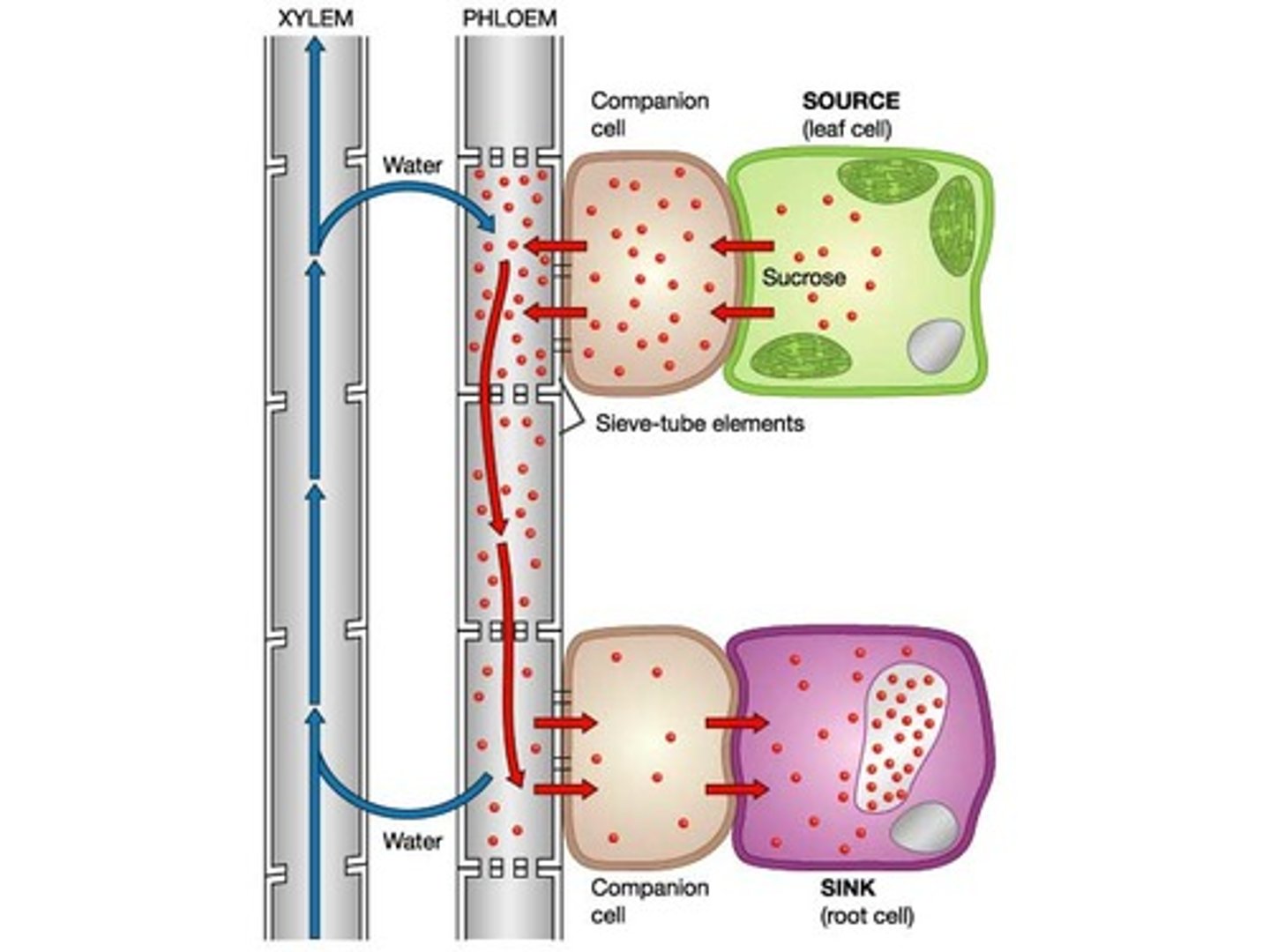
How does phloem transport organic materials like sucrose - Mass Flow Hypothesis ?
Sucrose loaded into Phloem at source/leaf - sucrose goes from leaf to phloem
Hydrogen Ions (H+) actively transported from companion cells into source/leaf
therefore, H+ diffuses back into companion cells from source
as they do, they pull in sucrose with them by co-transport
sucrose then diffuses into sieve tube
this lowers the water potential of sieve tube so water follows by osmosis from the xylem
This increases the hydrostatic pressure in the phloem
Phloem contents are pushed through the sieve
Sucrose unloaded from Phloem at Sink - sucrose moves out of phloem/sieve tube into sink by facilitated diffusion
This increases the water potential of the phloem compared to xylem as it’s losing solutes
Water leaves the phloem into the xylem reducing the hydrostatic pressure

What is the surface for gas exchange in plants?
In the spongy mesophyll cells in the leaf
What is Lactose Intolerance?
• Person does not make Lactase Enzyme
• Lactose remains Undigested
• Leads to Diarrhoea and Flatulence
• Undigested Lactose in Lumen of Intestine lowers it's water potential, so water enters the lumen by osmosis leading to water faeces (Diarrhoea)
• Undigested Lactose broken down by micro-organisms in Large Intestine, giving off gas (Flatulence)
What is digestion?
Breaking down large, insoluble molecules into small, soluble molecules which can be absorbed into the bloodstream
Which molecules don't need to go through digestion to be absorbed?
Already small molecules e.g. monosaccharides and minerals
What is the structure of the digestive system?
mouth, salivary glands ,esophagus, stomach, duodenum,jejuneum, illeum, large intestine, rectum, anus, liver, gallbladder

What is the structure of the small intestine?
duodenum - top part where enzymes from the pancreas & bile from the bile duct secrete into
jejunum - middle part where absorption begins of digestive material
ileum - last part where digested matter is absorbed
How is the polymer starch digested?
Amylase : first breaks down starch into maltoses by hydrolysing the alternate glycosidic bonds
Then membrane-bound disaccharidases : they hydrolyse the bonds in maltose to relase alpha glucose
Amylase is found in the salivary glands & pancreas where as the membrane-bound disaccharidases are found in the membrane of the epithelial cells in the illeum
What are the names of the different disacchardiases for the different disaccharides?
Sucrose - Sucrase
Maltose - Maltase
Lactose - Lactase
How are monosaccharides absorbed?
glucose and galactose are absorbed via co-transport with sodium ions; fructose passes via facilitated diffusion - all this happens across the epithelial membranes in the ileum and into the blood
What is the first step of lipid digestion?
The lipids are emulsified by bile salts to increase surface area.
Then lipase enzymes hydrolyse the ester bonds in triglycerides to form a monoglyceride and fatty acids.
This occurs in the small intestine but lipases are made in the pancreas.
What is the second step of lipid digestion?
Once the lipids are broken down into monoglycerides and fatty acids these molecules stick to bile salts.
This forms mielles which are tiny structures that constantly break up and reform releasing the monoglyerides etc.
This means they can be absorbed across the epithelial cell membrane through simple diffusion.
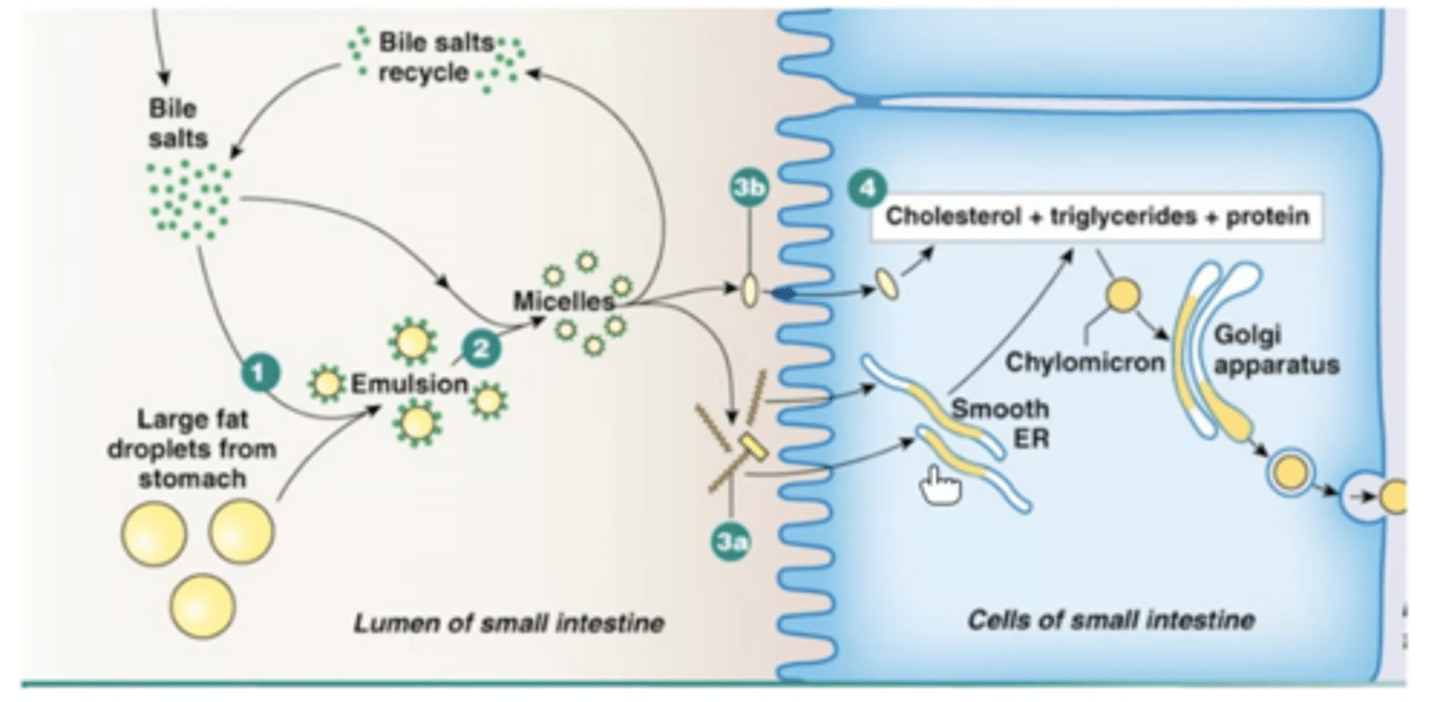
What doesn't happen in lipid digestion?
The mielles aren't absorbed! Only the molecules they release are absorbed.
Describe the absorption of lipids by a mammal, including the role of micelles.
Bile salts combine with monoglycerides and fatty acids to form micelles.
Micelles make monoglycerides and fatty acids (more) soluble in water.
Micelles carry fatty acids and monoglycerides to cells lining the ileum, where they break down to release them.
This maintains a high concentration of fatty acids and monoglycerides near cells lining the ileum.
Monoglycerides/ fatty acids are absorbed (into epithelial cells) by diffusion (as they’re lipid soluble).
Triglycerides formed in (epithelial) cells and aggregate into globules.
Globules coated with proteins forming chylomicrons which are then packaged into vesicles.
Vesicles move to cell membrane and fuse with it, releasing chylomicrons via exocytosis.
Chylomicrons enter lymphatic vessels and eventually return to blood circulation.
What is the first step of protein digestion?
The proteins are broken down by 2 different peptidases.
- Endopeptidases hydrolyse the peptide bonds in a protein forming poly-peptide fragments
- Exopeptidases then hydrolyse the peptide bonds at the end of protein molecules removing one amino acid at a time
---> Dipeptidases are a type of exopeptidase that works on dipeptides specifically and breaks them into 2 amino acids

Where can the different types of peptidases be found in the digestive system?
Some are produced/found in the stomach - pepsin
Some are made in the pancreas and then secreted into the small intestine - tryprin & ohymotyprin
Dipeptidases are found on the cell surface of epithelial cells in the small intestine.
What is the second step of protein digestion?
The newly formed amino acids are absorbed in a similar way to glucose & galactose - co-transport with a sodium ion
How is heat exchange effected by surface area to volume?
Rate of heat loss depends on its surface area to vol ration - the larger e.g. a mouse the more easily heat is lost so smaller organisms need a higher metabolic rate to keep warm compared to larger animals.
Animals with a more compact shape minimise heat loss but animals with a less compact shape have a lower S.A. to vol ratio so increase heat loss.
How are some animals adapted for better exchange?
Animals with a higher S.A to vol ratio tend to lose more water so some have kidney structure adaptations so that they produce less urine
To support higher metabolic rates, small animals need to eat large amounts of high energy foods
Smaller mammals may have thick layers of fur or hibernate
Larger animals may have body adaptations that give them lager surface area in order to increase heat loss
How do single celled organisms carry out gas exchange?
They’re able to have substances diffuse in and out directly across the cell membrane as that’s the only “barrier”.
This allows for a fast diffusion rate because of the short diffusion distance
Why can multicellular organisms not use the same method of gas exchange as single celled organisms?
Diffusion across the outer membrane would be too slow:
Some cells are deep in the body - large distance between them & outside environment
Low surface area to volume ratio meaning there is too small of an outer membrane for all the cells in the body
This means multicellular organisms have to use specialized exchange organs & an efficient system to transfer substances to all cells.
What are the factors required for a fast rate of diffusion?
Large surface area - more substances at one time
Short diffusion pathway
Steep concentration gradient
What is the structure of the gas exchange system for insects?
Spiracles - small holes on either side of an insects body/exoskeleton through which gases leave or enter the body
Tracheae - large impenetrable system of tubes connected to a spiracle
Tracheoles - very small tubes which grow into & between body cells - where exchange actually happens
How can insects “ventilate”?
Insects can ventilate to a small extent through abdomen compressions which squeeze air out of the tracheoles etc
How do insects maintain a high rate of gas exchange when most active?
The tracheoles have fluid in their ends so when an insect is very active & lactic acid builds up in their cells the water/fluid is drawn into their cells. This is because the lactic acid build up decreases water potential.
This means there’s less water in the tracheoles so more air is in contact in the tracheoles with the tissues so more oxygen is diffused in & more CO2 can be diffused out.
How do insects reduce water loss?
The spiracles have muscular valves around them which can close to reduce water loss and hairs around the spiracles can trap moist air also reducing water loss.
How does an insects gas exchange system meet the factors for a high rate of diffusion?
Large surface area - many microscopic tracheoles which go all the way into all the cells
Short diffusion pathway - short distance from air in tracheoles to cells & from the spiracles to tracheoles - however limits size of insect
Steep concentration gradient - maintained through cells doing respiration & through ventilation of tracheae by abdominal compressions
What is the gas exchange surface for fish?
The gills which are made up of the gill arch, gill filaments & lamellae.
Why is it not advantageous for fish to have water as their respiratory medium?
Air is roughly 21% oxygen but water is only 1% oxygen so fish have to pass large quantities of water over their gills.
How do fish ventilate?
The fish can open its mouth increasing volume & so decreasing pressure so water moves in.
The fish then closes its mouth and squeezes water over the gills so diffusion occurs & out of the fish.
This movement keeps the concentration gradient high.
How does the structure of the gills make for an efficient gas exchange system?
Many gill filaments which increases surface area
Lamellae at right angles to filaments further increases surface area
Gills have a rich blood supply over the lamellae so look pink
What is the counter current system of the gills?
Blood & water flow over lamella in opposite directions.
The water flows across the lamellae from highly oxygenated blood to less oxygenated blood & them to deoxygenated blood
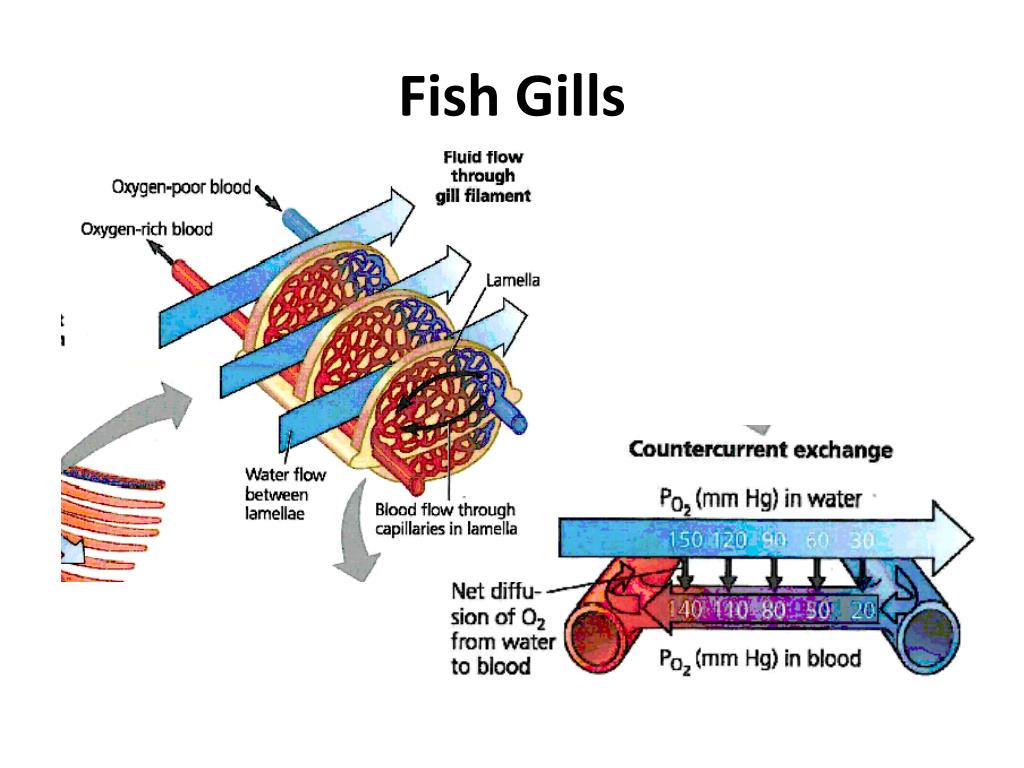
Why is the counter current system of the gills important?
Blood high in O2 meets water - max O2 conc - so O2 diffuses into the blood
Blood with little/no O2 meets water with most of the water removed O2 so O2 still diffuses into the blood
This doesn’t maximise the conc gradient but it does maintain it across the length of the gill plate so almost all of the O2 from the water diffuses into the blood via the lamellae.
What would happen if there wasn’t a counter current system?
The blood & water would eventually reach equilibrium while flowing across the gill plate etc so only 50% of the O2 in the water diffuses into the blood.
What is the structure of the human gas exchange system?

What are the lungs?
Pair of lobed structures made up of a series of branched tubules that end in tiny sacs called alveoli.
What are the bronchioles?
A series of subdivisions of the bronchi whoes walls are made with muscle and lined with epithelium cells. The muscle allows contraction and thus air flow into the alveoli.
What are the bronchi?
Bronchi = 2 bronchus where each one goes into each lung with a similar structure to the trachea. They also produce mucus to trap dust & dirt, cilia to move this towards the throat.
What is the trachea?
A flexible airway supported by rings of cartilage that prevent collapsing when breathing in. The walls are made up of muscle and lined with ciliated epithelial cells & goblet cells.
What are the intercostal muscles?
Muscles found between the ribs that come in 2 layers - internal & external.
What are the alveoli?
Minute air sacs lined with epithelium with collagen & elastic fibres. These allow them to stretch & recoil as ventilation occurs. Their membrane is the gas exchange surface.
How do alveoli achieve a very large surface area?
There are millions of microscopic air sacs - singular is an alveolus.
An alveolus also has a bumpy/ uneven shape which also increases the surface area compared to a perfectly spherical alveolus.
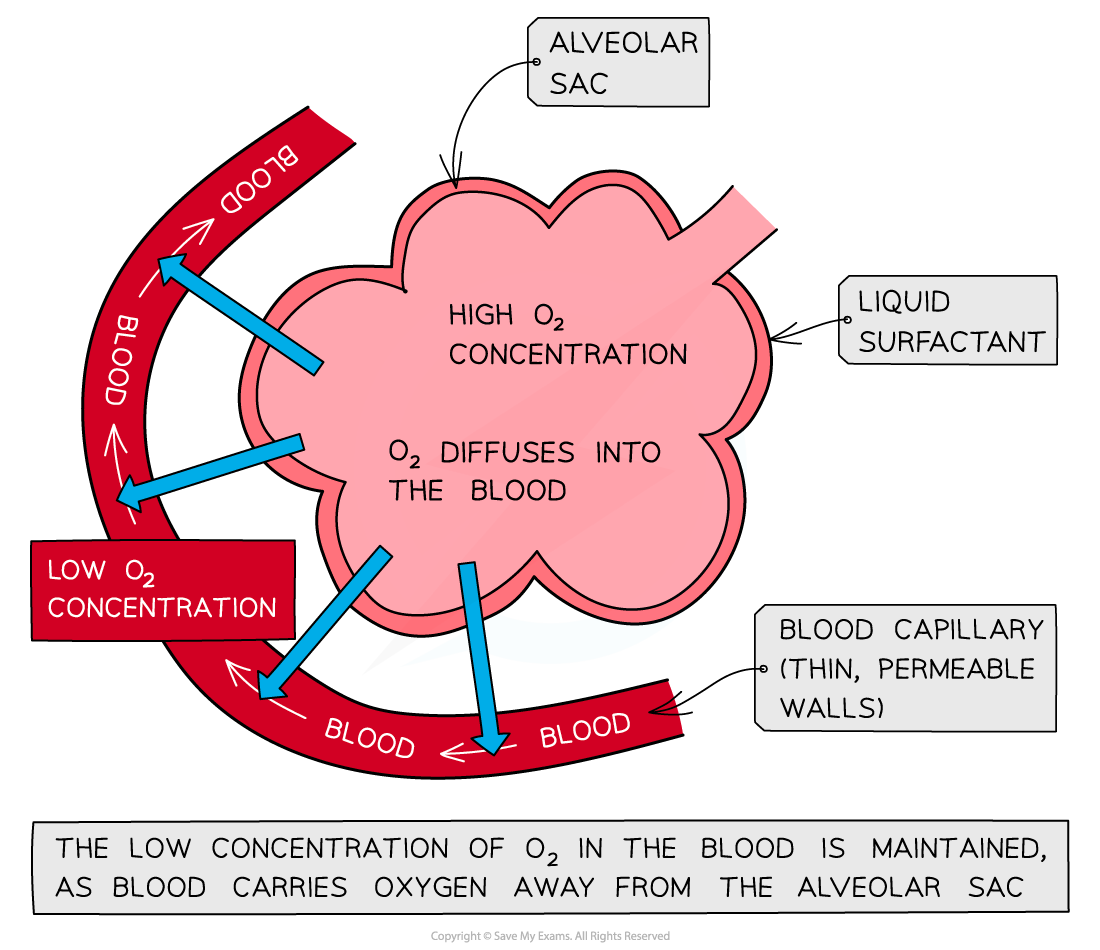
How is a steep concentration gradient maintained in the alveoli?
They have a very rich blood supply from the many capillaries surrounding the alveoli.
This means there is always a flow of blood transporting O2 away so deoxygenated blood is next to the alveoli.
The constant ventilation of the lungs also maintains a steep concentration gradient.
How do the alveoli ensure a short diffusion pathway?
Alveoli are made out of squamous epithelial cells.
Squamous epithelial cells are the most flattened/thinnest type of epithelial cell
This means the gases have a shorter distance to travel over so faster rate of diffusion.
What are expiration & inspiration (simple definitions)?
Expiration = breathing out
Inspiration = breathing in
How does ventilation occur in humans?
Inspiration - when atmospheric pressure is greater than the pressure in the lungs.
Expiration - when atmospheric pressure is less than the pressure in the lungs
What happens in inspiration?
External intercostal muscles contract
Internal intercostals relax
The ribs pull up and out
The diaphragm contracts causing it to flatten
Overall this causes the space in the thorax/chest cavity to increase so a reduction of the pressure in the lungs due to the increased space.
Air is forced into the lungs & avleoli expand and directly after this occurs the alveoli recoil in order to bounce back to their original shape forcing air & CO2 out.
What happens in expiration?
External intercostal muscles relax
The diaphragm relaxes returning to a dome shape
Unlike in inspiration both the internal intercostal & external intercostal muscles relax
This causes the volume of the thorax/chest cavity to decrease so there’s an increase in pulmonary pressure making it higher than the atmospheric pressure.
Air is forced out of the lungs
It is a passive process
When and how is expiration an active process?
When someone is exercising, expiration becomes an active process as the internal intercostal muscles contract forcing the ribs down. This reduces the volume of the thorax and increases pulmonary pressure.
This is done to increase breathing rate.
What are forced expiratory volume(FEV) and forced vital capacity?
Forced Expiratory Volume - maximum volume of air that can be breathed out - FEV1 is this but measured in one second
Forced Vital Capcity - maximum volume of air that you can force out of the lungs after a large breath in
What are the effects of tuberculosis?
Tuberculosis is a infectious disease caused by a bacteria.
When infected the immune system cells build a wall around the bacteria - tubercules where the tissue inside dies.
The damage to the alveoli reduces their surface area and so tidal volume.
This can also cause scarring - fibrosis - which further decreases tidal volume and increases the diffusion distance.Overall the rate of diffusion.
What are the symptoms of tuberculosis?
Someone with tuberculosis would experience a reduction of tidal volume so less air can be inhaled with each breath - ventilation rate increases
Persistent cough
Coughing up blood
Chest pains
Shortness of breath
Fatigue
What is fibrosis?
The formation of scar tissues due to infection - TB, exposure to asbestos etc
What are the effects of fibrosis?
Scar tissue makes the alveoli thicker so increases the diffusion pathway - reducing the rate of diffusion.
Scar tissue is also less elastic so tidal volume & FVC decreases due to inflexibility of alveoli.
What are the symptoms of fibrosis?
Faster ventilation rate
Shortness of breath
Dry cough
Chest pain
Fatigue & weakness
What is asthma/ an asthma attack?
Airways becoming inflamed & irritated often because of allergic reactions to pollen, dust etc.
During an asthma attack the smooth muscles lining the bronchioles contract making them narrow creating a difficulty to breathe which is furthered by a large amount of mucus being produced.
What are the effects of asthma/ an asthma attack?
Reduced air flow means the air in the lungs becomes stale so the conc gradient isn’t as steep and FEV1 is severely reduced.
Symptoms - wheezing, tighter chest & shortness of breath - this can be relieved with an inhaler which relaxes the smooth muscles in the bronchioles & airways
What is emphysema caused by?
Disease caused by long term exposure to air pollution & smoking.
Occurs when foreign particles get trapped in the alveoli causing inflammation attracting phagocytes which produce an enzyme that breaks down the elastin in the alveoli.
What are the effects of emphysema?
Breakdown of elastin by phagocytes means the lungs have less elastic recoil so don’t expel air as well - lowered con gradient.
In the long term it can lead to the destruction of the alveoli walls reducing the alveolis S.A by removing their bumpy shape - reduces rate of diffusion
What are the symptoms of emphysema?
Shortness of breath
Wheezing
Higher ventilation rate
The symptoms can be treated with oxygen if they are very severe.
What are the risk factors for lung diseases?
Smoking
Air pollution
Genetic makeup
Infections
Occupations
What is mass transport?
The bulk movement of gases or liquids in one direction, usually via a system of vessels and tubes.
Used by larger organisms which cannot simply diffuse substances to all cells in the body as there are many layers of cells etc - too large of a diffusion distance for the rate of diffusion to be fast enough.
What is the main mass transport system in mammals?
The circulatory system : the one-way flow of blood within the blood vessels carries essential nutrients and gases to all the cells of the body
What does it mean for the human circulatory system to be a closed double circulatory system?
Closed - the blood is always contained in blood vessels as it’s pumped around the body.
Some animals e.g. molluscs have open systems where blood is pumped directly into body cavities
Double - in one complete circuit of the body the blood goes through the heart twice - first from the heart to the lungs then back through heart and into the body
What are the pulmonary circulatory system & the systematic circulatory system?
Pulmonary circulatory system - the right side of the heart pumps deoxygenated blood to the lungs for gas exchange
Systematic circulatory system - blood then returns to the left side of the heart, so that oxygenated blood can be pumped efficiently (at high pressure) around the body

What are main body blood vessels to know?
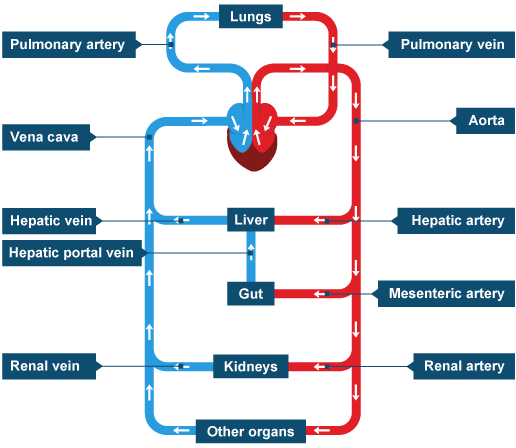
What is the structure of all larger blood vessels?
They have a 3 layer structure:
Inner layer = the endothelium - made up of a layer of flat squamous cells
this makes it smooth to prevent friction & prevent clotting so allows for smooth efficient blood flow
Middle layer - smooth muscle and elastin
elastin allows for recoil and stretch
Outer layer - connective tissue - made up of collagen
able to resist the pressure changes from within & outside the blood vessel
+ Lumen - the narrower the lumen the more pressure the blood is under
How are the structures of larger blood vessels - veins & arteries different to one another?
Arteries :
thicker smooth muscle & elastin layer lowers the pressure of the blood so capillaries don’t burst when given blood
and the stretch allows for recoil after a surge of blood to maintain blood pressure
arteries have smaller lumens in order to push blood everywhere around the body
Veins :
larger lumen in order to minimise the friction so blood goes back to the heart - thinner smooth muscle & elastin layer
contain valves in order to prevent the backflow of blood
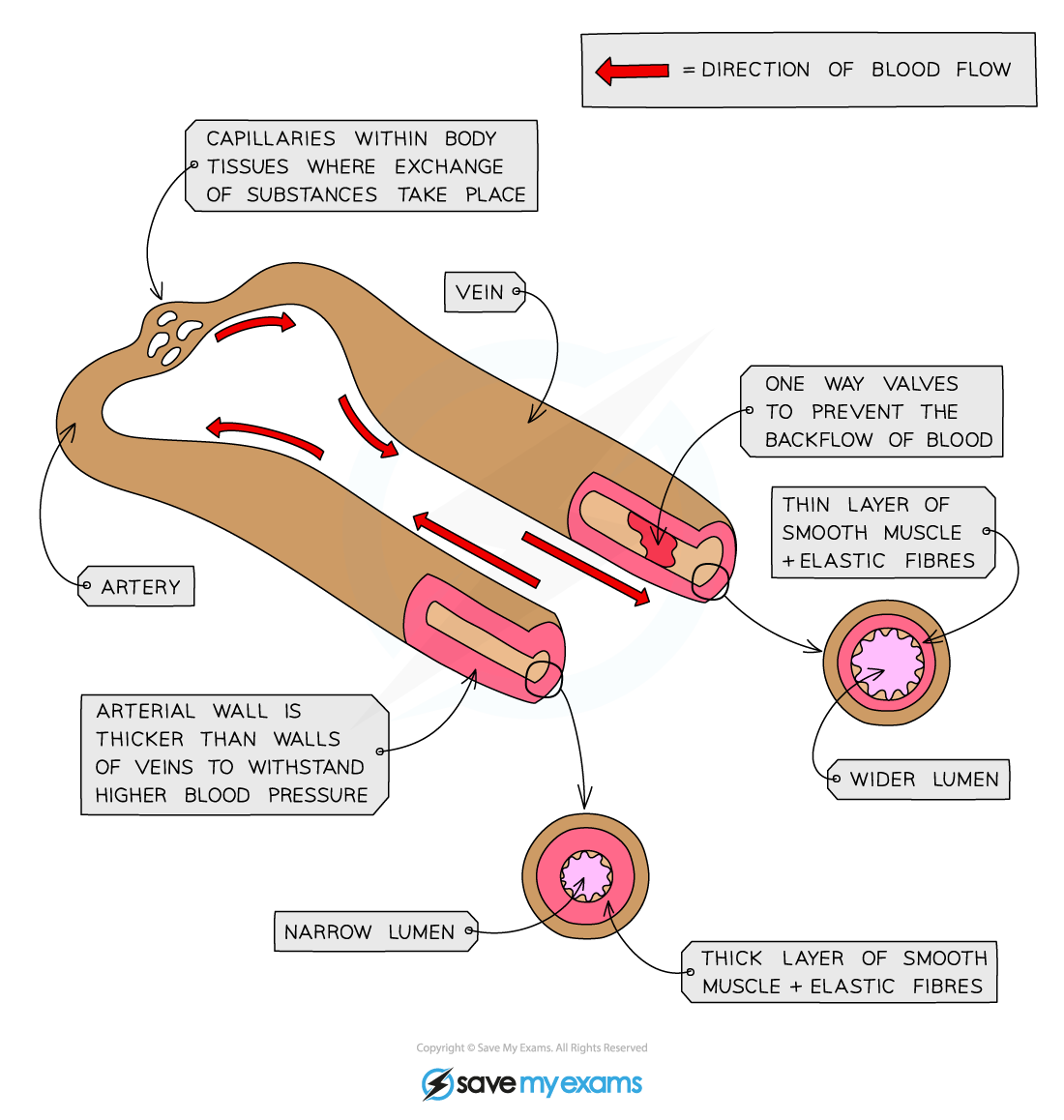
What are the arterioles?
They smaller blood vessels that come from the arteries.
Form a network around the body & direct blood to different areas of demand
This is able to happen through contractions of muscles inside the arterioles either restricting blood flow or relaxing for full blood flow
Similar structure to arteries but smaller scale